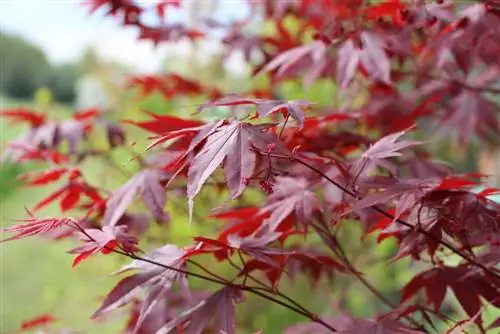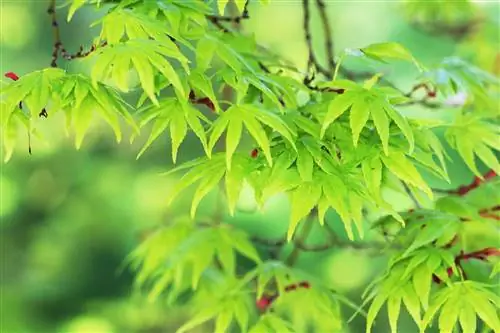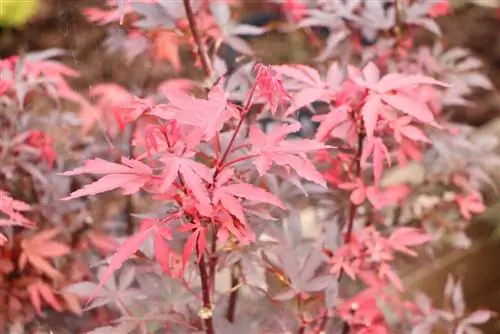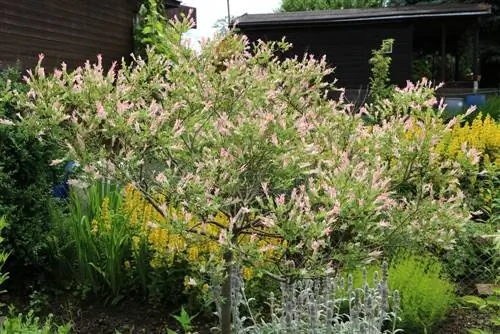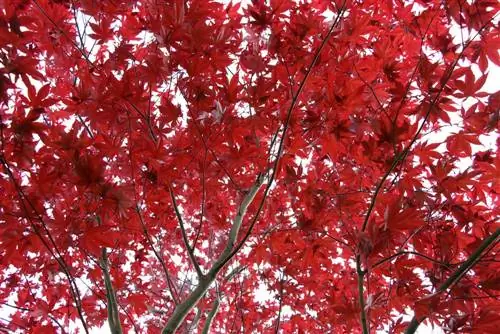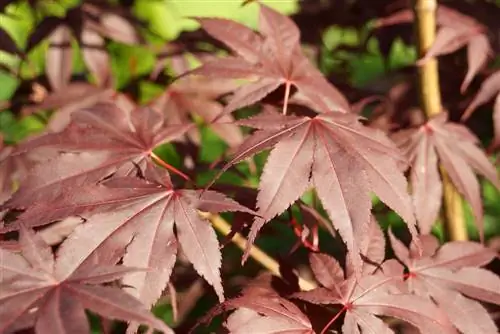- Author admin [email protected].
- Public 2023-12-17 03:39.
- Last modified 2025-01-24 12:45.
Japanese ornamental maple creates wonderfully beautiful garden images with its multifaceted varieties. The elegant tree or shrub has a changing look all year round, characterized by picturesque lobed leaves in beautiful colors. The performance culminates in a furious autumn spectacle, with colorful fireworks in carmine red, golden yellow, green and orange. Although the noble tree family thrives in a variety of growth forms, there are largely uniform requirements for proper cultivation. After reading these lines you will be very familiar with the central aspects regarding location, care and propagation.
Location
With a Japanese maple, creative hobby gardeners achieve impressive decorative effects by placing the tree against a backdrop of dark coniferous trees, in front of a wall, on outside steps or ponds. The compact trees or densely branched shrubs create eye-catching accents both in groups and in solitary positions. This applies equally to planting in beds and in large containers. In order for an ornamental maple to best meet the expectations placed on it, a location should be as follows:
- Sunny to semi-shady location
- Avoid wind-exposed locations with cold drafts if possible
- Well-drained soil with slightly acidic to neutral pH of 5.0 to 7.0
- Sandy loam soil or a structurally stable container plant substrate is ideal
Before planting, the soil is loosened to a depth of 30-50 centimeters to optimize air circulation. In damp places, a 50 percent mix of sand and gravel is essential to prevent harmful waterlogging. In addition, a 10 centimeter thick drainage layer effectively contributes to improving water permeability.
Tip:
Planting on a slightly raised hill provides effective protection against the threat of waterlogging in damp locations.
Care
Professional care focuses on a balanced supply of water and nutrients. All other aspects follow this, but should not be ignored.
- Water freshly planted Japanese ornamental maple regularly
- Well-established trees are content with normal rainfall
- In case of prolonged drought, water thoroughly without wetting the foliage
- A layer of mulch effectively prevents drought stress
- Provide with a mineral fertilizer in April or May
- Alternatively, add compost to the bed every 2-3 weeks from April to August
Regular fertilization is even more important in container culture than in well-maintained garden soil. An annual dosage of 1 gram of fertilizer per 1 liter of substrate should not be less than this. Experience has shown that after about 5 years the previous planter is too small. To repot into a larger pot, choose early spring to keep the stress factor for the Japanese maple as low as possible. If pre-fertilized substrate is used, this supply covers the needs of this year's season.
Cutting
The noble habitus of a Japanese ornamental maple does not require regular pruning. The tree does not tolerate such intervention very well, especially in autumn and winter. The cuts use fungal spores and pests to attack the tree or shrub. If individual branches grow out of the contour, they are cut off during the summer. The same applies to thinning out dead branches that are cut at the base. A cut into the old wood of a Japanese Japanese maple must be avoided at all costs, as it usually does not sprout again.
Wintering
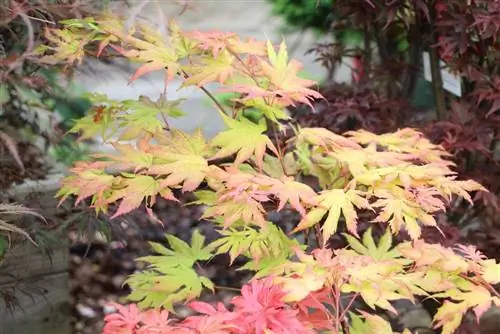
The Asian ornamental tree is completely hardy in the right location. If possible, a Japanese maple tree should not be exposed to cold easterly winds. Experienced hobby gardeners make sure that the tree or shrub can mature well before the first frost. Therefore, the application of fertilizer ends in the second half of August at the latest in order not to attract fresh shoots. Since a Japanese ornamental maple is less protected in a pot than in the garden soil, the following precautions should be taken:
- Before the first frost, cover the container with jute or bubble wrap
- Place on a block of wood in front of the south wall of the house
- Cover the substrate with bark mulch, leaf mold or pine needles
- If there is a clear frost, water a little on frost-free days
Tip:
Late frosts in May are generally a problem for a Japanese maple, regardless of its location. The new shoots cannot cope with extremely sub-zero temperatures. In this case, protect the tree with a garden fleece.
Propagate
In the hobby garden, vegetative propagation through cuttings is primarily considered. This method is easy to implement and produces a young plant with exactly the same attributes as its mother plant. Suitable offshoots are about 15 centimeters long, half woody and have 3-4 leaf nodes. Given an average success rate of 50 percent, several cuttings should be cut at once. The months of May, June and July have proven to be ideal for this form of propagation. Here's how to do it:
- Small cultivation pots are filled with peat sand, coconut fibers, perlite or commercially available pricking soil
- Insert a cutting in each so that two leaf nodes are above the substrate
- After moistening the soil, place a plastic bag over each container
- Ideally move the pots to an indoor greenhouse
In the following 8-10 weeks, a permanently humid, warm microclimate creates the ideal conditions for rapid rooting of the cuttings. The hood or mini greenhouse is ventilated briefly every day to prevent mold from forming. If new shoots appear at the shoot tips while the first root strands grow out of the bottom opening of the pot, the process is proceeding as planned. The cover can now be removed orthe plants move to a warm, protected, partially shaded location.
Repotting
Once the young plants have rooted through their cultivation pot, autumn is just around the corner in the garden. Planting a young Japanese ornamental maple at this early stage of growth would be associated with a high risk. It is therefore advisable to repot every well-rooted specimen and care for it indoors throughout the winter. How to do it right:
- The only possible containers are those with a bottom opening for water drainage
- Spread a drainage over it made of small shards of pottery or grit
- A water- and air-permeable fleece prevents soil crumbs from clogging the drainage
- Fill the planter halfway with high-quality potting soil
Press a small depression into the substrate with your fist. Place the still potted young plants with the root ball in water to soak them completely. Then pot up the small trees, place them in the middle of the hollow and fill the cavity with substrate. Forward-looking hobby gardeners do not forget to leave a small watering edge. Next spring from mid-May, plant the Japanese ornamental maple in its final location.
Diseases
In the right location and with appropriate care, Japanese ornamental maple proves to be a robust and resilient tree. If, on the other hand, the shallow-rooted plant is exposed to a substrate that is too wet, it is at risk from Verticillium wilt. This is a fungal infection that clogs the supply ducts over time. As a clearly visible symptom, the branches wilt in the middle of the season. Cut out the affected shoots immediately and check the site conditions. With a little luck, ventilation of the root area in conjunction with a reserved water supply will help save the Japanese maple.
Conclusion
Japanese ornamental maple creates impressive decorative effects in creative garden design. In order for the Asian ornamental tree to develop its full potential, the choice of location is crucial. The sunnier the location, the more magnificent the autumnal color spectacle is. This is accompanied by an adequate supply of water and nutrients, which is based in particular on balance. A Japanese maple tree cannot tolerate drought or permanent waterlogging. Although the application of fertilizer is desirable, it should end in August in order not to endanger safe wintering. The secateurs are only used on the Japanese ornamental maple in exceptional cases during the summer, for example to thin out dead wood, trim back branches or cut cuttings for propagation.

